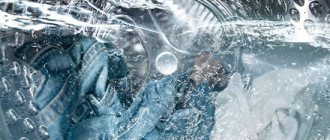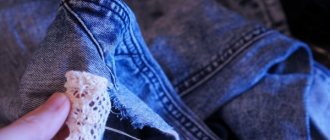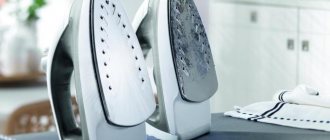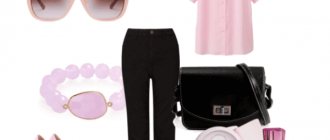Popular articles
Jeans are the favorite thing of millions.
Many wear it for a long time. And what a shame it is when a nasty stain appears on them that cannot be washed off with anything. We'll make a neat, professional rip in place of the stain! Like this!
We make two parallel cuts at the top and bottom of the spot.
We insert a wooden block under the cuts to make it convenient to work further
Use pumice stone or sandpaper to rub the stain so that it becomes softer and the threads fray a little.
Using tweezers, remove the blue threads, leaving the white ones at the bottom.
Now the stain needs to be painted over. Matte fabric paint is suitable. And a brush. Jessica took white paint.
But it turned out to be too white to hide the stain. And that’s why I added a little beige to it. Everyone chooses the tone of paint for their spot independently.
This is the kind of neat hole you will get.
Did you like the article? Subscribe to the channel to stay up to date with the most interesting materials
—Categories
- decor (498)
- home decorations (50)
- BOXES (42)
- FOOTWEAR (32)
- GIFTS, packaging (31)
- vases, glasses, wine glasses (19)
- kitchen ideas (16)
- FAST and EASY (15)
- from color magazines (14)
- burlap (10)
- BUTTERFLIES (10)
- OWN ARTIST (8)
- wine corks, rope (8)
- BAGS (6)
- palettes (6)
- lamps (6)
- boxes (6)
- collars (5)
- POMPOMS, feathers (3)
- IMAGE TRANSFER (3)
- from leftover wallpaper and more (3)
- cage (3)
- linen (2)
- shabby chic (1)
- rusty coating (1)
- disposable tableware (1)
- crafts (469)
- for the New Year (40)
- SIMPLE ideas (28)
- BOTTLES (28)
- plates, jars (25)
- from paper and newspapers (23)
- PAPIER-MACHE (21)
- for EASTER (20)
- FLOWERS (19)
- cardboard, towel rolls and t/b (17)
- tin cans (16)
- baskets, bowls, containers (15)
- Jewelry (13)
- GYPSUM (11)
- FRAMES and frames (10)
- pebbles - stones (8)
- Men's work (8)
- Cold porcelain (7)
- salted dough (6)
- candles (3)
- from orange peel, grapefruit (3)
- STEAMPUNK (2)
- LEAVES (2)
- interior mask (papier-mâché) (2)
- GARDEN on the window, balcony (2)
- made from balloons (2)
- birch bark, pine cones (2)
- pasta (1)
- HAMMOCK (1)
- STONE CARVING (aerated concrete) (1)
- house, what's in it (452)
- interior (78)
- pillows (65)
- ideas - renovation (43)
- KNOGS-BRANCHES-SNAGWAYS (20)
- curtains, blinds (20)
- how to decorate a blank wall (17)
- KITCHEN (12)
- windows, balconies and loggias (8)
- BEDROOM and children's room (6)
- bathroom (6)
- DOORS (5)
- how to arrange furniture (5)
- SHELVES (4)
- plants (4)
- poufs and floor pillows (4)
- how to organize a dressing room (4)
- MIRROR (3)
- FAMILY holidays (3)
- WATCH (3)
- moldings (3)
- little Tricks (3)
- LIVING ROOM (2)
- RUGS (2)
- PAPER dolls (interior and not only) (2)
- sofa (1)
- partitions (1)
- ceiling medallions (1)
- ironing board (1)
- Interior COLUMNS (1)
- folding table (1)
- stained glass (1)
- goodies (345)
- sewing (331)
- SIMPLE and FAST (82)
- BAGS, CASES (62)
- aprons, slippers (7)
- BUFFS, yo-yo (7)
- sleeves (5)
- soft toys (5)
- pincushions (4)
- headwear: hats, panamas, (4)
- bed linen (3)
- for beauty (292)
- HEALTH (47)
- physical training (6)
- Makeup RULES (3)
- perfumes, essential oils (2)
- alterations (281)
- T-shirts (60)
- updates (37)
- knitwear (32)
- jeans (26)
- FURNITURE (25)
- recycling (17)
- shirts, jackets (8)
- coloring (gradient, spray) (3)
- plastic toys (2)
- fashion (255)
- clothing: close-up details; BOHO (53)
- hair (16)
- how to wear scarves, shawls, long skirts (15)
- BAGS, shoes, wardrobe (8)
- men's theme (8)
- MANNEQUIN (8)
- body types and clothing (6)
- jeans, sweatshirts (3)
- COAT & PONCHO (3)
- Coco Chanel (1)
- crafts and crafts (202)
- stencils (22)
- ideas for your beloved self (17)
- stamps (11)
- storage systems (8)
- bracelets, pendants, buttons (8)
- boxes (various techniques) (7)
- polymer clay (4)
- about gypsum and castings (4)
- like MARBLE (3)
- RUGS (3)
- TAPESTRY (3)
- structural paste, putty (2)
- paper art (2)
- ROCK GARDEN (2)
- FELT (1)
- for drawing (160)
- WATERCOLORS (11)
- canvases (2)
- wax pencils, pastels (2)
- almost palette knife (2)
- diary usefulness (150)
- just in case - everything interesting (127)
- avatars and backgrounds (5)
- modeling (2)
- Artists that interest me (125)
- TIPS (119)
- housekeeping (49)
- fix zipper (4)
- update bag (1)
- stain on jeans (1)
- for computer (114)
- Summer - dacha (94)
- FLOWERS and vegetable gardens (12)
- tips (8)
- cement crafts: paths, vases, etc. (6)
- swimming pool (3)
- birdhouses (3)
- PICNIC (2)
- from old HOSE (1)
- grow MOSS (1)
- furniture experiments (94)
- LET'S UPDATE FURNITURE (29)
- from boxes and pallets (5)
- patina (3)
- aging (2)
- antique furniture (signs) (1)
- video (85)
- leather (75)
- painting (74)
- Scarf scarves (6)
- BATIK (5)
- programs (69)
- EMBROIDERY (68)
- hand stitches (41)
- ribbons (8)
- mosaic (54)
- eggshells (7)
- from CDs (5)
- from broken dishes (3)
- cereals, legumes (2)
- we will make the material for the mosaic ourselves (1)
- photo artists (51)
- make money on the Internet (47)
- Jewelry (41)
- button (6)
- Italy (41)
- fur (37)
- making soap (36)
- liquid soap (1)
- And sprinkles (1)
- Children's (33)
- Languages (31)
- English (23)
- Italian (3)
- cool things (26)
- auto (26)
- books (25)
- from old books (5)
- magazines (1)
- mine (23)
- VINTAGE (22)
- old photos (2)
- applique (21)
- CREAMS and Masks for face and body (21)
- Plastic (13)
- scrapbooking (13)
- my handicrafts (13)
- MY TRAVELS (12)
- Paris, Bordeaux (3)
- Italy, Rome (2)
- Sardinian crafts (1)
- parables (10)
- INTERIORS (9)
- how to take photos, video from photos (8)
- BUTTONS (6)
- WEDDING (6)
- for Cats and Dogs (4)
- SEA (3)
- FELT (1)
- decoupage, (190)
- silhouettes, pictures (17)
- furniture and accessories (4)
- we make glue, varnish ourselves (2)
- tiles (1)
- knitting (433)
- embroidery on knitted fabric (2)
- toys (80)
- dolls (34)
- WEAVING (75)
- from newspapers (5)
- braiding CORDS (4)
- from ribbons (2)
- from pine needles (1)
- daylily (1)
- blankets (11)
- patchwork (175)
- Miscellaneous - interesting (389)
- PEOPLE (89)
- need to know (83)
- HOLIDAYS (4)
- Paris (2)
- music (17)
Small specks
To paint over small spots, for example, from whiteness, it is enough to use ordinary stationery. To do this, select a marker, felt-tip pen or colored pencil according to color. Carefully sketch out the spot (you will have to remember coloring books from childhood). Turn the item inside out and cover with a piece of damp gauze. After this, go through the iron. If the denim is black, try applying liquid eyeliner or mascara.
Medium size spots
To eliminate larger white spots, other products will be needed. But they also help to quickly deal with the problem. At the same time, their cost is small.
Acrylic paints
With their help, you can not only hide a white stain, but also revive the design of your favorite trousers. Before painting over a white spot on your jeans, turn them inside out. Choose the required color. Using a convenient brush, paint over the stain itself. Place a regular sheet of paper on the reverse side and iron the item. Additionally, using a stencil and paints of other shades, you can make various patterns. Be prepared that with frequent washing, the pattern will quickly wash out.
Aerosols
Working with them is simple and fast. If you wish, you can buy stencils, or you can use old tights. Spray the contents of the can onto the fabric and let dry. No need to fuss with gauze or irons. It only takes a couple of seconds to spray paint your jeans.
Tips and tricks
In conclusion, we will share some tricks that will help make the process of removing yellow and other stains on jeans more effective and safe:
- almost all types of stains must be removed before washing so as not to provoke their deep penetration into the fabric structure;
- denim, if it is not white, can fade, so carry out all manipulations for cleaning the product on a light, dense fabric;
- do not rush, chasing quick results - aim for quality;
- try to eliminate stains on jeans as early as possible, because it is much more difficult to deal with old formations, and in some cases it is simply useless;
- hot water only fixes dirt on clothes;
- Before the main procedure, always perform a test on a piece of this or similar fabric.
Few people would be happy about a yellow spot on their favorite gins, especially before an important event. But there are no unsolvable problems! With a little skill and effort, your clothes will be clean again.
A normal person is unlikely to be happy about the appearance of yellow spots on things after wet cleaning. Even if you follow all the recommendations, you can remove fabric with unpleasant marks from the drum, which has to be sent to the wash again. There may be several reasons behind the appearance of untidy marks. To determine the root cause of their occurrence, you need to understand where they are located, how easily they are washed off, and which things in the load got dirty and which remained pristinely clean. Similar problems arise if cosmetics (foundation, sunscreen) get on the fabric, traces of sweat appear, or the washing powder does not dissolve well and leaves yellowish marks on the laundry.
What if the stains are very noticeable?
It is not always possible to get away with a slight fright. If you use too much chlorine bleach, the paint can fade over a large area of the fabric. Jeans also tend to fade in the sun. Such spots can no longer be spot-covered. You'll have to repaint the entire trousers. Two types of dyes can be used.
Blue
This is not a professional dye. Blue is a mixture of starch and methylene blue in different proportions. The effect of deep painting will not work, but refreshing the faded material will be quite possible.
For this:
- Blue is diluted in warm water strictly according to the instructions. Add a couple of tablespoons of table salt and stir until all components are dissolved. Now the trousers are immersed in this mixture for about three hours. For a more reliable result, the time can be extended to eight hours. Turn the trousers over every two hours so that the paint applies evenly.
- After the allotted time has passed, the item is wrung out well and rinsed in a solution of 9% table vinegar (2 tablespoons/l of water).
Powder paint
The peculiarity of this substance is that it can be used to process trousers both manually and by machine. Each method has its own advantages.
In the machine there is an automatic machine:
- The instructions will help you prepare the dye for use correctly.
- Dilute the paint in 0.5 liters of hot water and pour it into the drum. The powder tray must not be used!
- Next, put the jeans on and wash in the boiling mode at a temperature of 90 to 95 degrees.
- Meanwhile, prepare an aqueous solution of vinegar (according to the previously indicated proportion). Dip your pants in it for about 15 minutes. Then return them to the drum and select the “rinse and spin” mode. It is difficult to completely remove all moisture from denim with your hands.
Manual method:
- Pour a liter of water into an enamel or plastic container and stir the dye in it until the lumps are completely eliminated.
- If necessary according to the instructions, add additional baking soda and salt. Dilute the resulting concentrate with plenty of water (6 to 8 l).
- Place jeans in it and cook for 40 minutes over moderate heat, remembering to stir.
- Allow the trousers to cool slightly and then rinse three times. The first two times - in warm and cold water, and the last - in a vinegar solution. It will help the color stay bright longer.
Stains on jeans are not a reason to part with something dear to your heart. From a wide range of fabric dyes, you can always choose the one you need. Proceed slowly and strictly according to the manufacturers' recommendations. And if you like the result, you can update the color of your trousers regularly.
Bleach is an excellent assistant for the housewife who carefully monitors the appearance of her clothes and tries to give them a flawless, sparkling look. However, if used inappropriately - for example, taken in a larger proportion than necessary, or accidentally splashed onto clothes that were not planned to be bleached, it can cause very big troubles.
The chemical compounds included in the product - hypochlorite, calcium hydroxide, chloride - corrode the color and destroy the structure of the fabric. It will be impossible to repair the damage by washing the item. Folk remedies are also powerless here. There is only one option to correct the situation: you will have to figure out how to disguise the white spot.
How to hide a stain on jeans
Unfortunately, some stains cannot be removed from denim due to the rough structure of the fibers. But this doesn’t mean it’s time to throw away your favorite trousers. You can try to hide a stain on jeans using decorative elements and jewelry.
The easiest way is to stick a patch on it. This option to cover a stain on jeans is more suitable for those who adhere to a youth or informal style of clothing.
You can creatively bleach the stained area: this will help diversify the look of your jeans and give them originality. The procedure is very simple: you should drop a drop of white on the stain and wait 5-15 minutes until the area of the fabric brightens. Later, add a few more highlighted spots or artificial abrasions to emphasize the intended style and give the product an organic feel.
Another original option: paint over the contaminated area. To do this, you can use regular acrylic or aerosol paint (spray can). The substance should be applied to denim and wait until it dries. To create a drawing or pattern, it is recommended to use paper stencils.
"Ambulance"
Just to start with your favorite item, you need to provide “first aid”: stop the process of destroying the fabric by the bleach that gets on it. The stain must be thoroughly washed with cold running water. Just do not rub or wash it under any circumstances! Then treat with one of the substances:
- an aqueous solution of sodium thiosulfate (1 teaspoon per 1 glass of water); the drug is sold in pharmacies;
- baking soda mixed into a thick paste in cold water.
The product should be applied to the damaged area from the front and back. After 10 minutes, rinse thoroughly again under the tap. This will help remove any remaining chlorine from the fibers.
From bleach
- You can color it over with a blue ballpoint pen or marker. It is important to choose the ones that best match the color of your jeans. First, the stain should be carefully sketched. Then take a damp gauze cloth and iron the treated area through it with a hot iron, first from the front side, then from the back. The jeans can then be washed.
Advice . It is best to save the pen or marker that has been used. After several washes you will have to use them again.
- It all depends on where the unwanted spot is located. It is quite possible that the patch will look very natural on him. Nowadays a huge variety of them is offered in stores selling sewing supplies.
- As an option - paint over the stain with special paint for denim or blue. Here it is important to strictly follow the instructions so as not to completely ruin the item.
- If the stain is too large, and even located in the most conspicuous place, in order not to throw the thing away, there is nothing left to do but repaint it a darker color.
- You can turn blue jeans into spotted “varenki”, which were super popular in youth fashion in the 90s of the last century. Or boil the trousers until completely white.
Important! When boiling, you will have to use bleach. It should be remembered that it is highly toxic. Inhaling its vapors for a long time is dangerous to health. Therefore, when performing procedures, the window in the room should be kept open and work only with rubber gloves.
You can use either liquid or powder bleach.
- First you need to put a large pan of water on the fire. Add bleach to it (the dose is 2-3 times more than for regular washing with bleach).
- Meanwhile, twist the jeans into a tight rope. The more small folds there are on them, the more interesting the resulting pattern will be. The shape of the tourniquet should be secured somehow, for example, by tying it with strong twine.
- When the water boils, the jeans need to be lowered into it. Cook, stirring with a long wooden stick.
- During the boiling process, it is important to carefully monitor how the denim changes color. When it reaches the expected saturation, the jeans need to be taken out immediately.
- Dumplings should be doused with cold water to cool slightly, then untied and rinsed well. Then wash as usual.
Clue
If you need to boil your jeans to a more or less uniform white color, you don’t need to twist them into a rope, just put them in boiling water with bleach. Monitor the cooking process very carefully, regularly turning the jeans in the pan with a wooden stick so that the water and bleach can flow into each fold.
Finally, the transition points between a darker shade and a lighter one can be rubbed with a stiff clothes brush to give the item an even more stylish, worn look.
If a yellow bleach stain has formed on your white jeans, you can also try to remove it by treating it with one of the following products:
- ordinary household stain remover;
- hydrogen peroxide;
- powdered acetylsalicylic acid tablets (pharmaceutical Aspirin), diluted to a thick paste with water;
- paste of baking soda and water.
After applying any of the above products to the damaged area, the item should be allowed to sit with it for 20-30 minutes. Then rinse and wash as usual. If necessary, repeat the procedure.
Removing wine stains from jeans using special products
Part 3. “Special” means
1. We create “our own powder” from baking soda.
Mix soda with water and get a thick mass.
We apply it on top of the sawn wood. We wait for some time and see the result of the work.
Repeat until the contamination disappears completely.
2. “Myth” and hydrogen peroxide are a substance that will save your financial savings from new purchases.
You should have remembered from your school chemistry course that H2O2 can discolor fabric. Mix powder and hydrogen peroxide. For fear of ruining the fabric, start applying the “powder” in small proportions. To obtain a concentrated solution, increase the amount of H, unless of course the fabric has lost color.
3. Classic way
If the above methods for removing stains do not help, then wash your jeans in the washing machine. If the stain partially remains, then try to cool the water to a minimum, because in hot or warm water, the fabric will absorb much more liquid than usual. And because of this, they should dry their trousers on the street, and not at home.
4. We remember the advertisement about washing powders.
As a rule, household remedies often help, but there are times when you’ve already tried everything, but the piloma remains. Then we go to the supermarket and buy any powder we like. Follow the instructions written on the side of the box. Advice, choose these powders (any): “Frosch”; "Sarma Active"; "Vanish" "Myth" and so on.
To prevent such situations from happening again, you need to give up all bad habits and adopt a healthy lifestyle. After all, she is so beautiful, but behind a glass of alcohol she is empty and nightmarish.
From the green grass
- Pour 70-90 degree alcohol (instead, you can use 9% clear vinegar, hydrogen peroxide, vodka) for half an hour. Then wash the item as usual.
- Cover with baking soda for 1-2 hours and moisten, then wash thoroughly.
- You can mix ammonia with hydrogen peroxide (1:1). This mixture will help to effectively clean off old green grass stains that have already ingrained into the fabric. But here you need to act very carefully: make sure that the jeans do not discolor. It is better to test the product first, for example, on the back of the waistband of jeans.
From blood
A fresh stain should be washed under running water as cold as possible. Then wash with laundry soap. This should be done as quickly as possible, since the protein quickly penetrates into the structure of the tissue and, once dried, it will be much more difficult to remove it from there.
An old stain will first have to be soaked in warm water for a couple of hours. Then use one of three methods to remove the blood stain.
- You can fill it with glycerin for 20 minutes, then wash it in cold water with powder or laundry soap.
- Dilute ammonia in water (1:1) and pour the solution onto the stain for half an hour. Wash by hand.
- Mix starch, baking soda and table salt (1:1:1), dilute the mixture to a thick paste with cold water. Apply the composition to the damaged area of the fabric. Launder.
It is recommended to test this composition first to see if it will harm the fabric by discoloring it. A small drop should be applied, for example, to the inside of a pocket.
How to remove a stain from jeans
A blood stain can be easily removed by washing the jeans in cool water with a good powder, after treating the stain with oxygen bleach. There is no need to be afraid that the product will “eat” the paint - such bleaches do not contain chlorine, which has a detrimental effect on colored things.
If there is a trace of grass on your jeans, you will have to try hard, since grass stains eat into the structure of the fabric. In this case, a solution of vinegar (9%) or baking soda will be useful. The item is either soaked in vinegar for an hour and a half, or soda paste is applied to the stain. Then the jeans need to be thoroughly rinsed and washed.
Fresh wine stains can be sprinkled with salt, then treated with any stain remover. You can take note of this old method: a red wine stain can remove a white wine stain (a small amount of white wine should be applied to the stain, and then washed).
Paint stains can be removed with any solvent, but you need to do this carefully, as the substance can “eat” the color of the denim.
From fuel oil, machine oil
The following products will help you deal effectively with these stains.
- Toothpaste. It should be applied to the stain and left until it dries completely. Then wash it. You need to be careful not to use toothpastes with a whitening effect - these can discolor the denim.
- Chalk. It needs to be crushed into powder and poured thickly onto the area of contamination. Leave overnight. By morning the stain should disappear forever.
- Dishwashing gel . It perfectly dissolves fat-containing substances. The gel does not need to be diluted in water the day before application. After 15 minutes, the jeans can be rinsed from the gel and washed in the machine as usual.
- Gasoline and kerosene. Apply one of these products to a cotton swab and rub the stain with it. Just be careful not to press too hard to avoid damaging the fabric structure. Wash as usual.
From rust
Rust stains can appear not only because the owner of the jeans gets into it somewhere. Over time, rust can form on the fabric around metal rivets or buttons. The reason for this is numerous washes. In these places it is not very noticeable, but the very fact of the presence of stains is unpleasant. To remove rust, it must be dissolved in acid. For example, in lemon (3-4 grains per 1 tablespoon of water) or in natural freshly squeezed lemon juice. You can use an aqueous solution of 7-9% clear table vinegar.
One of the products should be applied to the fabric, wet it thoroughly, then iron the area with a hot iron through a gauze cloth, first from the front side, then from the back. After this, wash the jeans by hand with soap and warm water.
Denim clothing is quite dense and practical, but it can also become stained with complex stains. But you need to know how to remove them. You can return stained denim to its original appearance if you act quickly. It’s safer to use proven folk recipes that will not only get rid of stains, but also preserve the color and integrity of the material.
The most effective remedy
Usually we believe that a miraculous effect can be achieved using some unusual means. Sometimes this happens. But in the case of grass stains, ordinary laundry soap is a magic solution. If all the methods described above cannot always remove the stain 100%, then laundry soap breaks all records for the destruction of such contaminants. The alkaline reaction that occurs in fabric fibers under its influence really works wonders, so it will not be difficult to remove dirt from the grass.
The method is very simple:
- make a solution for soaking jeans by diluting the soap well in warm water and adding 1 tablespoon of ammonia;
- moisten the contaminated areas of the jeans with water and rub well with soap;
- immerse these areas in the prepared solution for 1 hour;
- rinse jeans in clean water;
- wash in washing machine.
So, just using what you always have on hand, you can tidy up your favorite jeans. Removing grass stains is not as difficult as it seems , and using our recommendations, you can handle it yourself without any problems.
How to remove stains on jeans
To combat various stains on denim, you can use both special detergents and folk remedies available in every home. In many cases, simple washing powder or laundry soap will help, and sometimes strong solvents may be needed.
What you use to clean the item will depend on what the item was stained with. For example, you can remove spilled and hardened glue using an acidic solution (1 tablespoon of vinegar per 1 glass of water). Dip a washcloth into the liquid and treat the stained area with it, and then rub it with a soft brush.
Chewing gum is removed using an iron. The jeans are laid out on an ironing board, the gum is covered with a paper napkin and the top is ironed with a hot iron.
It is important to remove any stain before the main wash, otherwise it will be much more difficult to get rid of it.
From bleach
Whiteness often leaves yellow stains on light-colored clothing. It is not always easy to deal with such pollution, but it is possible if you hurry. A fresh white stain can be removed using a stain remover. Traditional methods are also used. Hydrogen peroxide is used to remove such contaminants. Dip a cotton sponge in peroxide and thoroughly rub the stained area with it. Then the product is washed using powder and rinsed in water with the addition of conditioner.
If the contamination is more than 3 days old, you will need aspirin. 2 tablets are crushed into powder and diluted with warm water. The resulting mixture is applied to the stained area and left for 2-3 hours. After the time has passed, the product must be washed.
From bleach
When bleach gets on the fabric, it not only eats away the color, but also dissolves the fibers, which can lead to the appearance of a hole. For this reason, such stains need to be removed from jeans as quickly as possible. The contaminated area must be immediately treated with a mixture of 1 tbsp. l. water and 1 tsp. sodium thiosulfate.
A dry or liquid water-soluble pigment called “Blue” will help to paint over a white spot on blue jeans. To do this, the item is dipped into the diluted dye for a while, and then rinsed thoroughly (until the water becomes clear) and dried.
If a small whitish stain from bleach appears on your black jeans, you can simply paint it over. A marker, eyeliner and mascara, and a simple felt-tip pen are suitable for this purpose. When the painting process is completed, you need to place damp gauze on the wrong side and iron it with a hot iron.
If you can’t paint over a stain on your jeans, you can use bleach to turn them into “varenki.” A deep container is half filled with water, put on fire and, when the liquid boils, white is dissolved in it. Jeans are placed in a boiling mixture and boiled for a quarter of an hour. After 10 minutes, you need to check whether the product has changed color; if not, then you need to add more bleach and cook for another 15 minutes. The finished jeans are rinsed in cold water with the addition of a fragrant rinse aid, which will destroy the unpleasant smell of whiteness.
From hair dye
If the paint has already dried, it will be difficult to get rid of the stain. In this case, only a solvent will help. Apply a mixture of acetone and gasoline to the stain, leave for a quarter of an hour, then wash in warm water.
Washing soap or dishwashing gel will help remove a fresh stain. You need to prepare a soap solution, apply it to the stained area, rub a little and rinse well. You can also spray the stain with hairspray, leave for a quarter of an hour, and then wash with powder.
Where do yellow stains on jeans come from?
Most stains should be dealt with immediately after they appear. This approach guarantees their complete removal without damaging the integrity of the tissue. But before you take action, make sure the origin of the contamination. Yellow stains on jeans are formed when the product comes into contact with:
Warning: Yellow stains may occur as a result of using deodorant. Cosmetic components react with sweat (urea), leaving persistent pale yellow stains, especially on white clothes.
Not so obvious, but very real reasons for yellow spots on jeans are:
- washing powder in high concentration;
- stagnant water in the steam iron;
- bleach;
- high humidity (more than 70%) in the room where clothes are stored;
- metal salts in hard tap water.
Important: if you notice that the soap does not foam well, and a white coating is constantly forming on the plumbing in the bathroom, it is likely that you are dealing with water of increased hardness.
How to remove scuffs on jeans
Dyeing will help remove scuffs on jeans. This method will help disguise the white stripes that appear over time on the knees, near the pockets. You can effectively hide flaws with a universal industrial dye. When performing the procedure, you must adhere to the following instructions:
- Choose a large pan, fill it with water and dissolve the paint. It is important to adhere to the proportions indicated on the packaging with the dye.
- The jeans must be straightened well; if folds remain, the coloring will be uneven. You can attach belt loops to a trouser hanger.
- The container with paint is placed on fire and brought to the required temperature. Then the item is carefully lowered into the liquid and everything is thoroughly mixed.
- The product should boil for half an hour. To obtain a more intense color, you can extend the process up to 1 hour.
Place the dyed trousers in cold water and rinse several times. When the water becomes clear, wring out the jeans and dry them.










